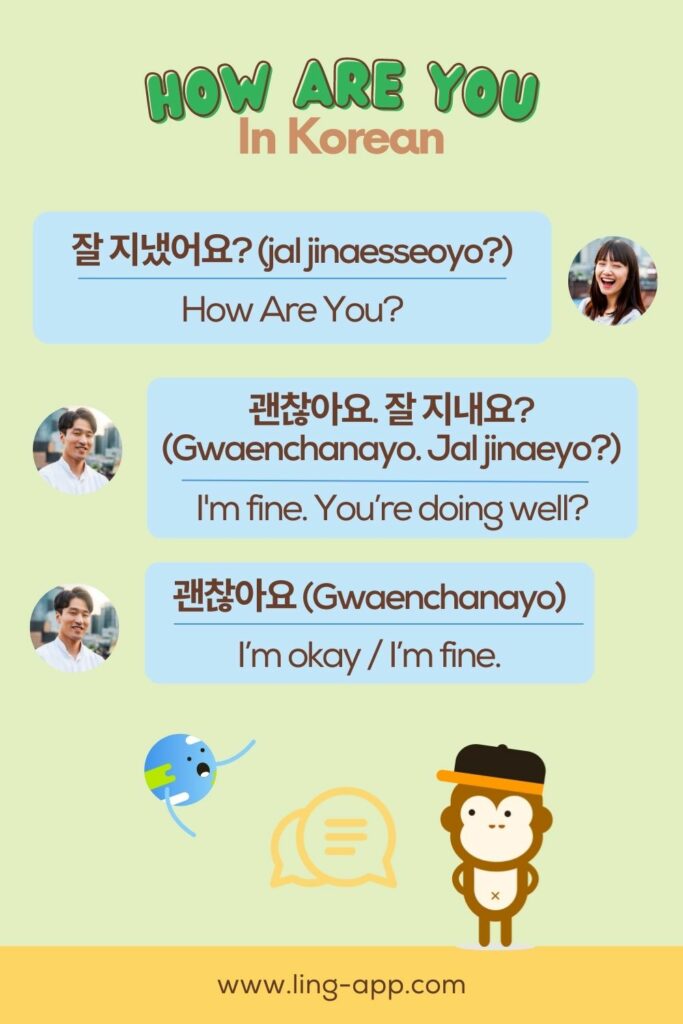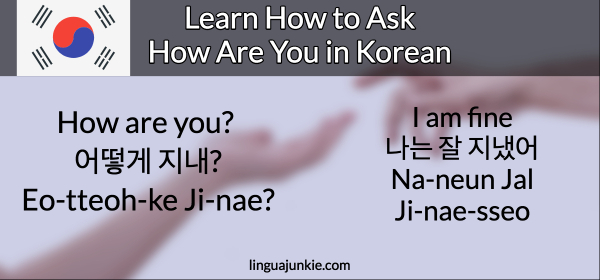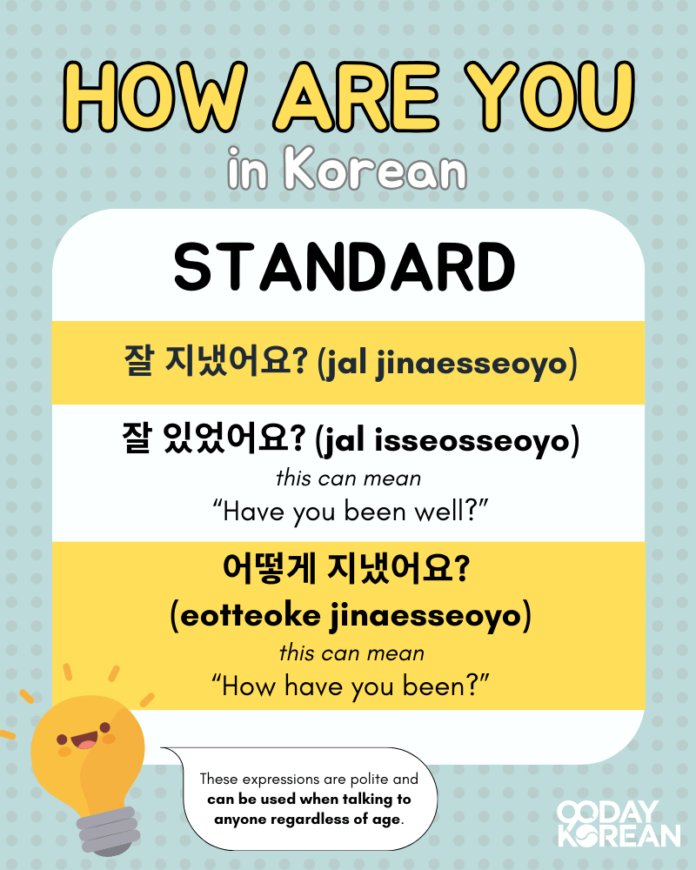How are You in Korean? The phrase “How are you?” In Korean is “어떻게 지내세요?”
This is a common greeting in Korea. When meeting someone new or catching up with an acquaintance, it’s natural to start with a simple “How are you? ” It sets a friendly tone and shows that you care about the other person’s well-being.
In Korean culture, showing respect and concern for others is highly valued, making this greeting an important part of social interactions. Whether you’re meeting a business contact, a friend, or a family member, starting with “어떻게 지내세요? ” Can help build rapport and create a positive connection. It’s a small phrase that can go a long way in making someone feel welcomed and valued.
The Importance Of Politeness In Korean Culture
High-context Communication
Korean culture values indirect and nuanced communication, known as high-context communication. This means that speakers rely heavily on non-verbal cues and context to convey their messages.
Hierarchy And Respect
In Korean culture, hierarchy and respect are deeply ingrained values. Politeness is crucial when addressing others, and the use of appropriate honorifics and formal language is highly emphasized.
Foundation Of Korean Greetings
Explore the foundation of Korean greetings by learning how to ask ‘How are you in Korean‘. Understanding these basics can enhance cultural interactions and language proficiency.
Koreans consider greetings as an essential aspect of their culture, and they put a lot of emphasis on it. Greetings in Korean are not only a way to acknowledge someone’s presence but also show respect and build relationships. Korean greetings also reflect their hierarchical society, where people of lower status show respect to those of higher status. Therefore, understanding the foundation of Korean greetings is crucial to communicate effectively in Korean society.
Common Greeting Phrases
In the Korean language, there are different ways of saying “hello” depending on the time of day, social status, and the relationship between the speakers. Here are some common greeting phrases used in Korean:
| Greeting | Meaning |
|---|---|
| Annyeonghaseyo | Hello (formal) |
| Annyeong | Hello (informal) |
| Yeoboseyo | Hello (on the phone) |
| Jaljayo | Goodbye (informal) |
| Annyeonghi gyeseyo | Goodbye (formal) |
Cultural Nuances
Korean greetings are not just about the words but also about the non-verbal cues. For example, when greeting someone older or of higher status, Koreans bow their heads slightly as a sign of respect. They also use honorifics to show respect, such as adding “-nim” to someone’s name. It’s also essential to note that in Korean culture, it’s considered impolite to greet someone without acknowledging their presence first.
Therefore, it’s common to say “annyong haseyo” as a greeting while entering a room or meeting someone for the first time. In conclusion, understanding the foundation of Korean greetings is crucial to effectively communicate and build relationships in Korean society. By using the appropriate greeting phrases and cultural nuances, you can show respect and build a positive impression.
Formal Language: Honorifics And Deference
In Korean culture, the use of honorifics and deference is an important aspect of communication. Understanding and utilizing these speech levels correctly is crucial when addressing someone in a formal setting. Let’s delve deeper into the concept of honorifics and how they shape the Korean language.
Understanding Honorifics
Honorifics, known as ‘josa’ in Korean, are linguistic elements used to show respect and politeness when speaking to others. They reflect the hierarchical structure of Korean society, where individuals are ranked based on age, social status, and position. Honorifics are used to address superiors, elders, and individuals of higher social standing.
There are various honorific suffixes and verb endings that are attached to nouns, verbs, and adjectives to convey respect. For example, the honorific suffix ‘님’ (nim) is added to names or titles to show respect, such as ‘선생님’ (seonsaengnim) for teacher or ‘아버님’ (abeonim) for father.
Using Formal Speech Levels
In addition to honorifics, the Korean language employs formal speech levels, also known as ‘jondaetmal.’ These levels are used to convey respect and deference based on the social status and relationship between the speaker and the listener.
There are three main levels of formality in Korean: plain, polite, and honorific. The plain form is used when speaking casually with friends or peers, while the polite form is employed when addressing strangers or individuals of higher social status. The honorific form is reserved for situations where a high level of respect is required, such as speaking to elders or superiors.
Each speech level has its unique verb endings, honorifics, and sentence structures. It is essential to use the appropriate level of formality to avoid any unintended offense or disrespect.
Summary
Honorifics and deference play a vital role in Korean culture and language. Understanding the proper usage of honorifics and formal speech levels is essential for effective communication and showing respect. By utilizing these linguistic elements correctly, you can navigate formal situations in Korean society with confidence and cultural sensitivity.

Credit: www.youtube.com
Casual Speech: Communicating With Peers
Casual speech is essential for effectively communicating with peers in Korean. Whether you’re engaging in a conversation with friends or colleagues, using the appropriate informal language structure and common phrases can help you build rapport and establish a sense of camaraderie. In this section, we’ll explore the nuances of casual speech in Korean and the common phrases used among friends.
Informal Language Structure
When conversing casually with peers in Korean, it’s important to use the informal language structure, which differs from formal speech. This includes using casual verb endings and omitting honorifics when addressing friends and acquaintances. The informal speech style fosters a more relaxed and friendly atmosphere, allowing for open communication and a sense of closeness.
Common Phrases Among Friends
When interacting with friends in Korean, there are several common phrases that are frequently used to express familiarity and camaraderie. These phrases often include casual greetings, slang terms, and informal expressions that reflect the close relationship between friends. Utilizing these phrases can help solidify bonds and create a comfortable environment for communication.
The Key Phrase: ‘how Are You?’ In Different Contexts
When learning a new language, it’s important to understand how certain phrases can vary depending on the context. In Korean, the key phrase “How are you?” has both formal and informal variations, each with their own appropriate responses. Let’s explore these variations and how they can be used in different situations.
Formal And Informal Variations
In Korean, the formal way to ask “How are you?” is “어떠세요?” (eotteoseyo?). This is typically used when speaking to someone older or in a more professional setting. On the other hand, the informal way to ask is “어떻게 지내?” (eotteoke jinae?), which is used when speaking to friends, family, or someone of the same age group.
Here is an example of how the formal and informal variations can be used:
| Context | Formal | Informal |
|---|---|---|
| Meeting a business client | 어떠세요? | – |
| Talking to a friend | – | 어떻게 지내? |
Appropriate Responses
When someone asks you “How are you?” in Korean, it’s important to know how to respond accordingly. Here are some appropriate responses for both the formal and informal variations:
Formal:
- “잘 지내고 있습니다.” (jal jinaego issseumnida.) – I’m doing well.
- “보통입니다.” (botongimnida.) – I’m okay.
- “조금 피곤하네요.” (jogeum pigonhaneoyo.) – I’m a bit tired.
Informal:
- “잘 지내.” (jal jinae.) – I’m doing well.
- “괜찮아.” (gwaenchana.) – I’m okay.
- “조금 피곤해.” (jogeum pigonhae.) – I’m a bit tired.
Remember, using the appropriate response based on the context is key to effective communication in Korean. Whether you’re speaking formally or informally, these variations of “How are you?” will help you navigate conversations with ease.

Credit: ling-app.com
Body Language And Non-verbal Cues
Body language and non-verbal cues play a significant role in communication, often conveying more than words alone. Understanding the gestures and facial expressions used in Korean culture can enhance your ability to connect with others. In this section, we’ll explore the importance of body language and non-verbal cues in Korean communication, focusing on gestures and facial expressions.
Gestures And Their Meanings
In Korean culture, certain gestures carry specific meanings that may differ from those in other cultures. For instance, beckoning someone with a finger is considered rude, while using the entire hand to gesture is more polite. Understanding these nuances can help avoid misunderstandings and show respect in interactions.
Facial Expressions In Conversation
Facial expressions are particularly important in Korean communication, often conveying emotions and attitudes. Maintaining eye contact is essential to show attentiveness and respect, while smiling is a universal sign of warmth and friendliness. However, excessive smiling can be perceived as insincere, so it’s important to strike a balance.
Practice Makes Perfect: Tips For Quick Mastery
When learning how to say “How are you?” in Korean, practicing consistently is key.
Language Learning Techniques
Repetition helps language retention.
Cultural Immersion Strategies
Interacting with native speakers aids fluency.
Real-life Application: Polite Phrases In Situational Dialogues
Discover how to greet in Korean with “How are You” in real-life scenarios. Polite phrases in situational dialogues enhance cultural understanding.
At The Workplace
In a professional setting, using polite phrases helps foster positive relationships. When greeting colleagues in Korean, saying “안녕하세요?” is common. To show respect, use “어떻게 지내세요?” to ask “How are you?” Respond with “잘 지내고 있습니다, 고맙습니다” meaning “I’m doing well, thank you.”
In Social Gatherings
During social events, using polite Korean phrases can enhance social interactions. When meeting new people, starting with “안녕하세요?” is polite. To ask “How are you?” use “어떻게 지내세요?” For a casual response, say “잘 지내, 고마워” meaning “I’m good, thank you.” At the workplace: – Greet with “안녕하세요?” – Ask “How are you?” with “어떻게 지내세요?” – Respond “잘 지내고 있습니다, 고맙습니다” In social gatherings: – Start with “안녕하세요?” – Ask “How are you?” with “어떻게 지내세요?” – Casual response: “잘 지내, 고마워”

Credit: www.linguajunkie.com
Frequently Asked Questions
How Do You Say “how Are You?” In Korean?
In Korean, the phrase “How are you? ” Is translated as “Annyeonghaseyo? ” (안녕하세요? ). It is a common greeting used to ask about someone’s well-being or to initiate a conversation. Koreans often use this phrase when meeting someone for the first time or in formal settings.
What Are Some Common Responses To “how Are You?” In Korean?
In Korean culture, common responses to “How are you? ” Include “Jal jinaeyo” (잘 지내요) which means “I’m doing well” or “Gwaenchanayo” (괜찮아요) which means “I’m fine. ” These responses are polite and reflect a positive state of well-being.
Are There Any Informal Ways To Ask “how Are You?” In Korean?
Yes, in informal situations, Koreans often use the phrase “Eotteohge jinae? ” (어떻게 지내? ). It is a more casual way of asking “How are you? ” And is commonly used among friends or peers. However, it is important to note that formal language is preferred in most formal or professional settings.
Is It Necessary To Use Honorifics When Asking “how Are You?” In Korean?
Yes, it is considered polite to use honorifics when asking “How are you? ” In Korean. Addressing someone with respect is an important aspect of Korean culture. Using the appropriate honorifics, such as adding “-yo” (요) at the end of the question, shows proper etiquette and respect towards the person being addressed.
Conclusion
To sum up, learning how to say “how are you” in Korean is a simple but essential step in communicating with native speakers. By mastering this phrase, you can start a conversation and build relationships with Korean people. It’s important to remember that language learning is a journey, so don’t be discouraged if you struggle at first.
Practice regularly and don’t be afraid to make mistakes, and you’ll be well on your way to becoming fluent in Korean.


